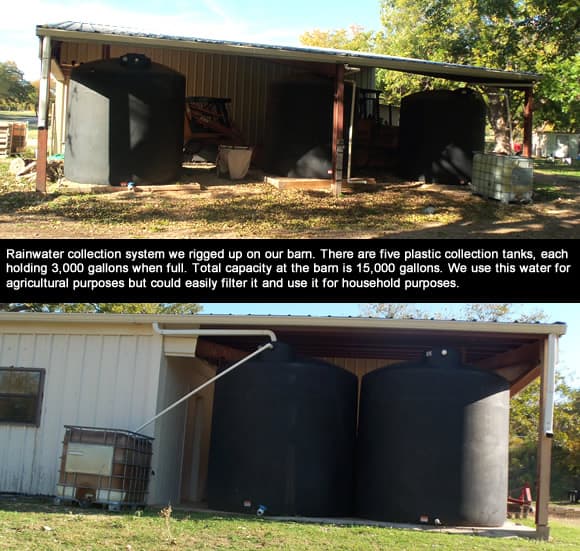Water is essential to life, for we cannot exist without it. We are running short of fresh, clean water in many parts of the USA. That is also the case in many other countries. Those who live in the northeastern quadrant of the lower 48 states are generally in good shape for now, water-wise, though there may be local issues with clean water in places. But as you travel west of the Mississippi, average annual rainfall drops off sharply, particularly in the desert southwest, which includes portions of the Chihuahua, Sonora, and Mohave Deserts.
The situation is particularly foreboding in the Colorado River Basin. There are more demands for the water than the river can reliably supply. Las Vegas is vulnerable to a water emergency, as are Phoenix and Tucson. Thirsty Los Angeles gets drinking water from far away Northern California via the California Aqueduct. As the podcast from a few weeks ago highlighted, water management and access is becoming an ever-increasing concern for many parts of the country.
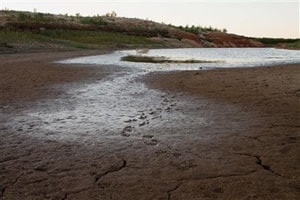 Here in Texas, where I live on a ranch, we have been hard-hit by an exceptional drought. Meteorologists forecast a continuation of this drought through next summer – and believe me, last summer was absolutely brutal. Those of us with livestock got hammered, with hay selling for $120 per round bale in my area. Rural water districts imposed severe restrictions, and in some cases outdoor watering was banned entirely. Pastures turned to dirt from lack of rain. Subsurface moisture disappeared. Crops withered.
Here in Texas, where I live on a ranch, we have been hard-hit by an exceptional drought. Meteorologists forecast a continuation of this drought through next summer – and believe me, last summer was absolutely brutal. Those of us with livestock got hammered, with hay selling for $120 per round bale in my area. Rural water districts imposed severe restrictions, and in some cases outdoor watering was banned entirely. Pastures turned to dirt from lack of rain. Subsurface moisture disappeared. Crops withered.
Most CM readers probably live in urban or suburban areas and may not be so interested in the difficulties faced by agricultural producers in Texas. But you will be affected in due course, when the price of beef rises as producers eventually begin to rebuild their herds. Texas farmers and ranchers have sold off much of their livestock because they cannot afford to feed the animals.
But enough of this tale of woe; let’s concentrate on constructive things we can all do to ensure a supply of safe water for drinking, cooking, and household use (washing; flushing the toilet; watering that veggie garden). It matters little where you live, for it does not take much imagination to think of circumstances where things could go wrong with the water supply that most people take for granted.
If you have taken the steps in the WSID Guide to ensure that you have a short-term emergency supply of water and a filtration method, you have your first base covered. Now it's time to look at long-term water access to cover your bases for extended droughts and water emergencies that you may have to live through.
What will you do if a day comes when you turn the tap on and nothing comes out? You finally get through to the water utility and learn that the outage might last for days. If you make a few preparations now at modest cost, you can deal with that at minimal inconvenience should it happen.
Let’s take this a step further: Suppose the population in your locality overwhelms the ability of the water utilities to meet the demand. It could happen. Planners try to think many years into the future and attempt to ensure an ample supply of potable water. But things can go wrong. For example, we are living in an era of budget austerity, and that might endure for some time. It costs fabulous sums of money to create a large-scale water delivery system – and funding is short.
Some municipal water utilities rely solely on electric pumps to deliver water through a series of pipes to the end users. Suppose the electrical power fails for an extended period. Think it can’t happen? Ever heard of Murphy’s Law? Well, Murphy was an incorrigible optimist. Of course, we all hope for the best, for that is human nature. It is wise, however, to prepare for less favorable outcomes. The good news is that (a) it’s possible, (b) it’s not difficult, and (c) it can be inexpensive.
Rainwater Harvesting
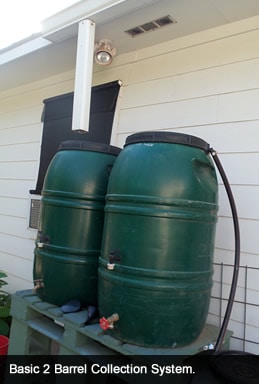 While rainwater harvesting systems can be quite inexpensive (e.g., a barrel under a downspout), they can be as complex and sophisticated as you please. The sky is the limit. You can overspend an unlimited budget if you are so inclined. From long experience, I would discourage needless complexity. The old “KISS” rule is best – Keep It Simple, Stupid. There is much wisdom and economy in that old saying.
While rainwater harvesting systems can be quite inexpensive (e.g., a barrel under a downspout), they can be as complex and sophisticated as you please. The sky is the limit. You can overspend an unlimited budget if you are so inclined. From long experience, I would discourage needless complexity. The old “KISS” rule is best – Keep It Simple, Stupid. There is much wisdom and economy in that old saying.
In its most basic form, rainwater harvesting consists of a collection component (a rooftop, plastic sheeting on a hillside, or any other non-permeable surface with enough area to collect rainfall when it occurs), a channeling component (gutters and downspout, hoses, or piping), debris filtering method (to keep leaves and sediment to a minimum), and storage system (above-ground barrels or water tanks, cisterns, etc).
 Let’s say that you are growing a vegetable garden and have some flowerbeds that you lovingly tend. Plants love rainwater. They do much better on rainwater than on treated city water. Have you noticed how plants perk up following a rainstorm? They don’t react the same way to being watered using a garden hose. As long as you don’t plan to drink the water, it does not much matter what kind of roof you have. Take a look at your home site. If it is level ground, then you are somewhat limited in how much rainwater you can collect, unless you put in a cistern of some kind below grade level. Most people would not want large rainwater tanks under each downspout, though small ones can be hidden behind shrubbery.
Let’s say that you are growing a vegetable garden and have some flowerbeds that you lovingly tend. Plants love rainwater. They do much better on rainwater than on treated city water. Have you noticed how plants perk up following a rainstorm? They don’t react the same way to being watered using a garden hose. As long as you don’t plan to drink the water, it does not much matter what kind of roof you have. Take a look at your home site. If it is level ground, then you are somewhat limited in how much rainwater you can collect, unless you put in a cistern of some kind below grade level. Most people would not want large rainwater tanks under each downspout, though small ones can be hidden behind shrubbery.
Cisterns come in several forms, such as concrete or ferrocement. On a level lot, a problem with cisterns is that you have to hire a backhoe or excavator to dig a hole, and that’s expensive. Then, because the cistern is below grade level, you have to use an electric pump to run your irrigation system. That starts to violate the KISS rule.
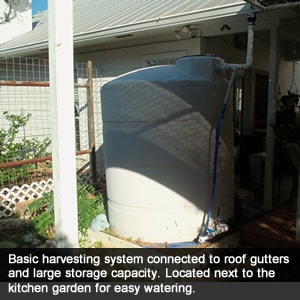 If you have a sloping lot, lucky you! The rainwater collection tank can be placed at the low end of the lot and gravity flow will fill it when it rains. You’ll need some sort of rough filter (e.g., a simple screen) to keep leaves and twigs from getting into your collection tank. You’ll still need to pump the water back up when you use it on your flowerbeds or garden, though. Hello, electricity. We are so dependent on electricity – no getting away from it for most of us. That’s a whole other topic and beyond the scope of this article, along with Peak Oil and a lot of other nasty peaks that are peeking over the horizon.
If you have a sloping lot, lucky you! The rainwater collection tank can be placed at the low end of the lot and gravity flow will fill it when it rains. You’ll need some sort of rough filter (e.g., a simple screen) to keep leaves and twigs from getting into your collection tank. You’ll still need to pump the water back up when you use it on your flowerbeds or garden, though. Hello, electricity. We are so dependent on electricity – no getting away from it for most of us. That’s a whole other topic and beyond the scope of this article, along with Peak Oil and a lot of other nasty peaks that are peeking over the horizon.
That brings us to potable rainwater harvesting systems. Out the window goes the KISS system; for now we’re talking complexity. First you need an appropriate roof. Metal is best. Again, you need a collection system, which means gutters, downspouts, one or more collector pipes, a rough filter, and a storage tank. The rough filter is sometimes known as a “roof washer” and it can be as simple as a bit of screen wire mounted to a metal frame that the water in the collection pipe must flow through before it goes into the storage tank (there are also other ways of doing this). The screen keeps twigs, leaves, and other debris from getting into the tank. You’ll need to clean the screen after every rain.
As soon as you collect the rainwater, it starts to accumulate bacteria. You can deal with this in a couple of ways. One way is to add chlorine (bleach or tablets), which takes care of the bacteria. But chlorine dissipates fairly quickly, so you will have to do this on a regular schedule. Be careful – chlorine is a deadly poison, so determine how much you need to add and be as precise as possible.
Before you consume the water, you must make it potable, which means running it through some sort of filtration system and then pumping it into your house for everyday use.
I can honestly state that I’m an expert on fully potable, entire-household rainwater harvesting systems, because I acquired my expertise the hard way – through trial and error and by making just about every conceivable permutation and combination of mistakes along the way.
A bit of history to put things in perspective: when my wife and I bought this property about 17 years ago, it was raw land, so we had the opportunity to build our dream home. Ours was a simple dream of country living – nothing fancy, but comfortable, with plenty of elbow room (good fences make good neighbors, and all). A talented friend designed the house for us. It’s on a steeply sloping lot on top of a hill – ideal for a rainwater harvesting system. I researched everything carefully and we designed it as state-of-the-art for the time.
The house has a heavy gauge metal roof with gutters and downspouts flowing the water into an underground central collection pipe. The water flows downhill through a German-engineered centrifugal filter that removes debris, before flowing into a 16,000 gallon fiberglass storage tank. The original system included a chlorinator pump that kept the water moving slowly in the big tank and added chlorine constantly, but that proved to be a nuisance and a maintenance headache. Later we removed the chlorinator when we upgraded the system.
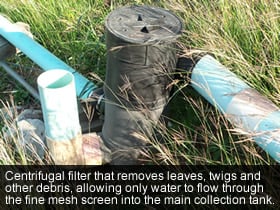
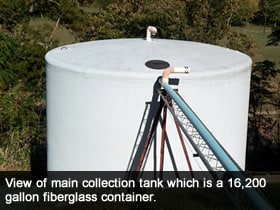
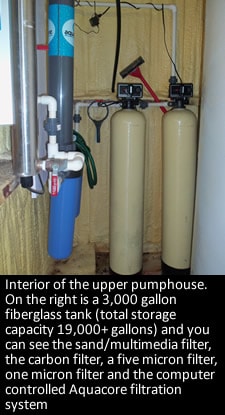 From the main collection tank, a stainless-steel pump sends the water uphill to a heavily insulated metal building with a 3,000 gallon fiberglass tank and a truly Byzantine array of pumps, valves, pipes, pressure tanks, filters, microprocessors, etc. The water is pumped into the 3,000 gallon tank. From there it goes through a sand/multimedia filter, a carbon filter, a five micron filter, a one micron filter and finally through a sophisticated Aquacore computer controlled filtration device before being pumped into the house. A series of pressure tanks maintains constant water pressure and reduces the load on the pumps. Finally, inside the house we have a reverse osmosis filter that supplies water to the refrigerator icemaker and a tap next to the kitchen sink. It’s the best tasting water I’ve ever experienced, and it ought to be, considering how much I’ve invested in the system over the years.
From the main collection tank, a stainless-steel pump sends the water uphill to a heavily insulated metal building with a 3,000 gallon fiberglass tank and a truly Byzantine array of pumps, valves, pipes, pressure tanks, filters, microprocessors, etc. The water is pumped into the 3,000 gallon tank. From there it goes through a sand/multimedia filter, a carbon filter, a five micron filter, a one micron filter and finally through a sophisticated Aquacore computer controlled filtration device before being pumped into the house. A series of pressure tanks maintains constant water pressure and reduces the load on the pumps. Finally, inside the house we have a reverse osmosis filter that supplies water to the refrigerator icemaker and a tap next to the kitchen sink. It’s the best tasting water I’ve ever experienced, and it ought to be, considering how much I’ve invested in the system over the years.
I learned many expensive lessons along the way. For example, stainless steel pumps don’t rust. The original pumps were cast iron. After a while we noticed that our water looked rusty. Yep, you guessed it... In came stainless steel pumps, and out went the rust, along with a considerable number of dollars. We now have a great system and no regrets – well, maybe a few, but too few to mention. I would do it all over again, but this time I’d get it right the first time.
I emphasize here that you do not need to do what I’ve done unless your circumstances absolutely require it, and that would be rare. Most people may only need to have an inexpensive emergency backup system to filter water for drinking purposes. With the benefit of hindsight, I spent a lot of money that probably was not necessary, but I got an education along the way and I’m sharing that with you here. Learn from my mistakes and save yourself the expense. Here in parched Texas, I’m happy to have this system (which provides a 100 day supply with full tanks), but a similarly sized non-potable system would have been much less costly. As it happens, we have access to a community water system, so that could provide drinking water and the rainwater could supply our other needs.
Water Conservation
That brings me to water conservation. It’s a good idea to do a water audit of your home to see where you can save on water. For example, a front-loading washing machine uses less water than a top-loader. Turning the shower water off while you shampoo your hair saves water. Low-flow showerheads and water-saving toilets also conserve water. Much water is wasted needlessly. Water is becoming a precious commodity, and it should be treated accordingly. It’s not too much of a stretch to say that one day fresh, clean water may become the new gold.
By the way, before you set about putting in a rainwater harvesting system, be sure to check and make sure you are not violating a local ordinance or state law. Believe it or not, there are laws in some places restricting your right to collect the rain that falls on your property. Until recently, in the State of Colorado it was illegal to harvest rainwater. That law has been repealed, as I understand it, and the trend elsewhere is similar. I’ve even heard of cases (though I have no specifics to share) in which local authorities require rainwater collection to be metered and a fee paid based on the number of gallons collected. From there it’s only a short step to charging people for the air they breathe. I suppose nothing much should surprise us these days.
For those interested in rainwater harvesting, there is a formula for calculating the amount of water you can expect to collect based on the size of your roof. I won’t go into the details here, but if you are interested, please send me a private message with your contact information and I will send you the formula. Wherever you happen to live, I hope you will recognize clean water for the precious, scarce commodity it has become, and treat it with the respect it deserves.
Water is just one of the many issues we must deal with as we prepare for whatever the future holds. I credit Chris Martenson’s Crash Course with helping me realize, three years ago, that I needed to make some common-sense preparations in case things start to get ugly. I’ve been an enrolled member since early 2009 and I reckon it has been a good investment. This “What Should I Do?” series draws upon specialized knowledge that members of the CM community have accumulated -- for some of us, the hard way -- and are happy to share with others. Good luck with your own preparations.
- BSV
Resources:
- CM Forum Definitive Water Thread
- Rainwater Harvesting Entry in Wikipedia
- Water Storage: Tanks, Cisterns, Aquifers, and Ponds for Domestic Supply, Fire and Emergency Use--Includes How to Make Ferrocement Water Tanks
- Rainwater Harvesting for Drylands (Vol. 1): Guiding Principles to Welcome Rain into Your Life And Landscape
- Rainwater harvesting calculator and system sizing formulas
This is a companion discussion topic for the original entry at https://peakprosperity.com/rainwater-harvesting-2/
